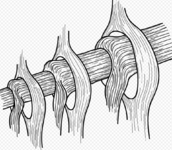I disagree with the whole premise. I seek to leave zero scar. I always cut back with a concave cutter to the point of origin as deep into the trunk as I can, without (this is the mucho muy importante point), without damaging the collar of trunk bark which is the live bark that will grow over the "valley" that I leave. To the same extent that the often wrinkled collar is damaged or removed, the tree will be slower to grow over the cut, even to the point that if all of that wrinkled bark is removed, it may never cover the wound until tree doubles or triples or more in diameter. That wrinkled bark is ugly(?) because it is live and growing and is essentially dammed-up by the branch which is in the way. That is the sign of healthy, growing bark and is species-specific in appearance. The bigger that lump is, the quicker it can spread out over the wound, if and only if, it remains undamaged when removing the branch. So, do the least damage to remove only the branch poking out and none of the trunk wood.
As to checking of the wood of the branch origin inside the trunk that is too deep to reach without damaging the surrounding trunk wood: all wood shrinks as it dries and only cracks if part of it drys before the whole thing drys out. Checking is overcome by kiln drying for lumber intended for decorative uses wherein the atmosphere is temperature and humidity controlled to slow down the process to rates appropriate to a given species and board size. Lumber intended for structural uses are air dried and often twists and turns and splits and that's the price paid to retain the maximum strength and flexibility of wood. You can mimic that process by sealing the ends of a log and setting it aside long enough for the drying process to occur slowly enough for the whole piece of wood to shrink at the same rate by forcing diffusion of the moisture in a log. That means that the moisture level within the different densities of dense inner core and outer less dense wood remains in balance for the whole length of time it takes for the whole mass of wood to reach a cured level of moisture. It can take a year for a 12" diameter log. Kiln-dried wood is said to be "killed", and air-dried wood is said to be "live". Killed wood is more suitable for interior uses because it moves less with changes in humidity level.
So, seal the cut immediately to insure three things: 1. To keep the moisture level at the same level of the interior of the trunk until it is shrunk to its maximum point; 2. Overlap the edges of the cut with the sealer to protect the exposed cambium layer surrounding the cut 360°; and 3. To prevent the entry of airborne pathogens and bugs that detect the odor of the sap which is often species-specific (Eg: Box Elder Bugs seek wounded Box Elder trees, et al).


 bonsaitonight.com
bonsaitonight.com

 bonsaitonight.com
bonsaitonight.com


